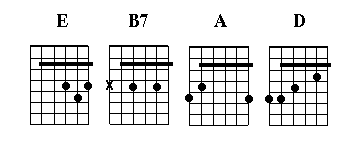

Most people understand the partial capo as an alternative or a substitute to altered tunings. While it is true that they behave in similar ways, and since there are partial capo "equivalents" to many common tunings, it's a reasonable way to look at the partial capo. However, capos and tunings are not at all the same, and they present different sets of possibilities, and it can be frustrating if you are used to using tunings, since you get similar but not the same the sounds with a partial capo. Partial capos can easily be used together with altered tunings, and a number of very fruitful combinations are already in use.
Before you can grasp how the partial capo works, you need to examine the tuning vs. the capo version of Drop D tuning, since it generates the "Aha!" realization about how partial capos work.
Let's examine the difference between non-standard tunings and partial capoing is to consider the common Drop D tuning, and compare it with its partial-capoed rough equivalent, which we call Drop E. If you have a Third Hand, or a Shubb, Kyser, or other open-jaw style capo (or the exciting new Liberty FLIP capo) that can be used to clamp a Drop E, you may want to read this page with guitar in hand.
Drop D Tuning
In Drop D tuning the low E string is tuned down one whole step to D. It has the effect of giving almost any fingering of a D family chord a big, fat, glorious tonic bass. The three bass strings on the guitar are D, A, and D, two tonics and a strong 5th bass for any D chord. You can play any D or D minor or D7 on the three treble strings anywhere on the fretboard and use all three bass strings all the time without ever tying up even one finger. That's nice. You can play melody or riffs freely anywhere on the neck as long as they can be harmonized with any D family chord.
Drop D tuning is used almost exclusively to play in the key of D, or sometimes D minor. Even in these keys it has some drawbacks. The most obvious of these is the IV chord, or G. The tonic bass that props up the IV chord is on the sixth string, the string that has been retuned. That means that bass note has migrated from the third fret up to the fifth. While this is not insurmountable, it is inconvenient. Some of the licks that fall easily under your fingers while playing a conventional G chord are either more difficult or not available in Drop D.
The key of D minor also has some problems. The drop chord, C, which is common in that key, loses access to its alternate bass on the sixth string. While this may not seem like a big problem, the weak drop chord really has a marked negative impact on that key. The contrast between the very strong I minor chord and the weakened drop chord is very evident.

All six string barre chords lose their bottom note in Drop D. Some of these are important chords in the D keys. Consider the common E form barre chord. In standard tuning it has a strong tonic bass on the sixth string. In Drop D it loses that. That means that good options for both the IV and V chords have been significantly weakened, not a small problem.
Drop E Partial CapoNow let's look at Drop E partial capo configuration. Instead of tuning the E string down a whole step, we're going to clamp all the other strings up a whole step. Finger a D shape chord, and you will find that you can play it as a six string chord, just as in Drop D tuning. It also has a low tonic bass on the sixth string.
Think it through. The open, unclamped sixth string is an E note. The D chord you're playing has been turned into an E by being capoed up a whole step. So it follows that you can play the D shape chord (actual pitch is E) as a six string chord with a tonic bass on the sixth string, just like in Drop D tuning.
The fundamental difference between tuning and capoing becomes clear when you play the IV chord, the one that looks like a G. Unlike Drop D tuning, where the sixth string bass note for the IV chord is displaced by retuning, in Drop E partial capo configuration the IV chord plays normally. So does the Drop chord in the minor key. So do all the barre chords. This is very useful.

There is one fly in the ointment, although a minor one. The II minor chord (the Em fingering) loses it's sixth string tonic bass. That is an important chord in some songs in this key, although in thousands of songs it doesn't show up at all. Fortunately, if you are using a low profile open jaw capo to clamp the Drop E, it isn't too difficult to reach over the capo to get that bass note back. Or you might decide this is the wrong configuration for a song that relies heavily on the II minor.
It's also worth noting that while Drop D tuning is only useful in the keys of D or D minor, Drop E can be cross keyed to wonderful effect. Playing in G position (actual pitch A), you get a standard I chord, a standard IV chord, and a V chord with a gift low tonic bass note on the sixth string. This is worth considering for almost any G position I-IV-V song. The fingerings are all normal, but one of the most important chords in the key is noticably improved. Another cute trick this configuration lends itself to is starting a song in C position, with C, F, and G shapes as the I, IV, and V chords, all of which finger normally, and then modulating up to D at some point in the song. It sounds as though you didn't just change the key, but the tuning as well.
Summary...By now the difference between a non-standard tuning and a partial capo should be coming into focus. When you retune, all of the notes on any string which has been retuned are displaced by one fret for every half step of retuning. The fingerboard can very quickly become an unfamiliar place. The common fingerings of chords and scales which we have all put so much time into mastering are lost.
Of course this is not in itself a bad thing. Open tunings are great ways to discover musical combinations you might never stumble across in standard tuning. Open tunings open new doors, but they also close others. In many tunings the doors which are opened are outnumbered by those which are closed.
This is not necessarily a problem. If all you're trying to do is arrange one song, then all any tuning has to do is provide the fingerings that will do that job. The things which may not be possible in that tuning are irrelevant.
Standard tuning is standard because it offers the most versatility. You can play with relative convenience in many different keys using standard tuning. Non-standard tunings are much more specific. Usually they're effective in only one key. A particular tuning may give you a great I chord, a cool IV chord, and an acceptable V chord, but perhaps offer no good way to finger a relative minor. This is why most people who use open tunings a lot, use a lot of different open tunings. Otherwise everything starts to sound the same.
In contrast, partial capoing only alters chords and scales where one of the unclamped strings is played open. Barre chords and closed position scales are entirely unaffected. Many nut position chords are fingered normally as well, depending on the configuration. A partial capo can give you access to open tuning-like tonalities, and to chord voicings not available in standard tuning, without turning your fingerboard into terra incognito.
[Home]